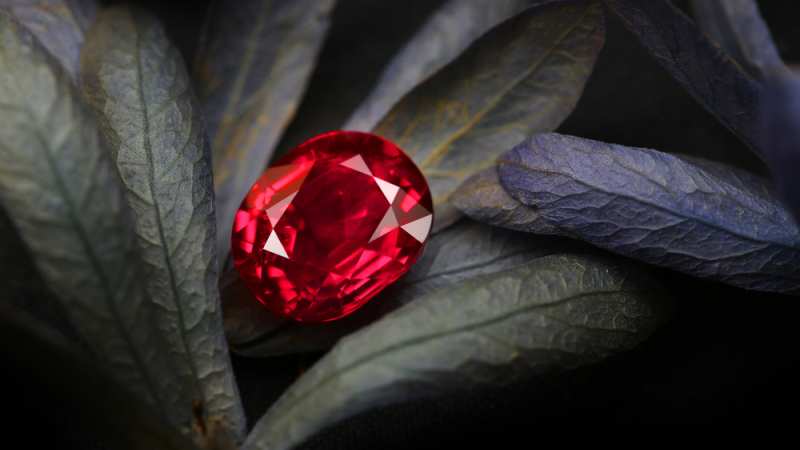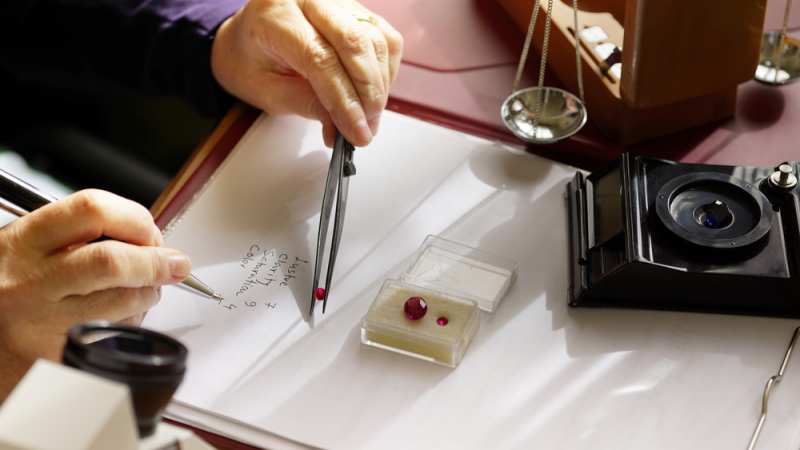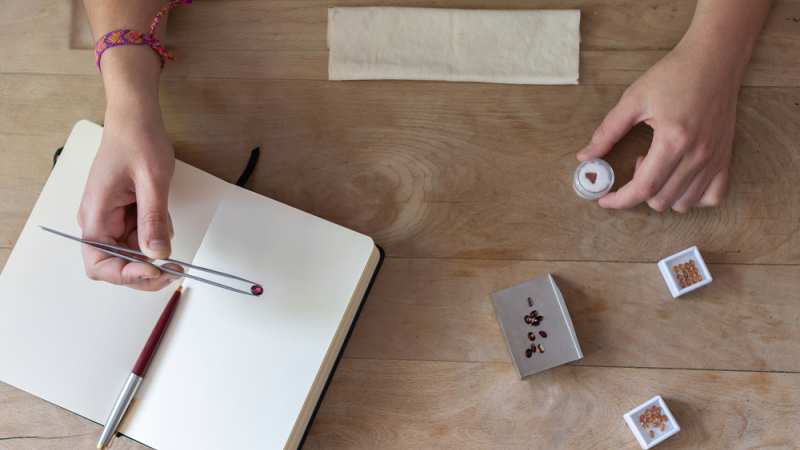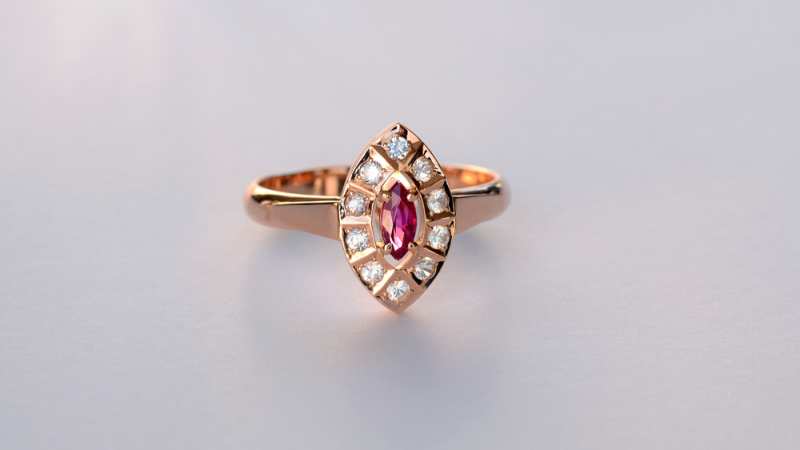Diamonds are highly sought-after gemstones for jewelry, particularly in rings, due to their exquisite beauty. However, it is not uncommon to wonder if diamonds can be combined with other gemstones in jewelry, such as rubies.
The answer is yes, you can wear diamonds and rubies together if you choose to. However, it is worth noting that according to Vedic astrology, the combination of diamond and ruby should not be worn by the same person.
Now, you may be curious as to why this is the case. In this article, we will delve into the reasons behind this belief. But before we do, let’s explore some fascinating facts about rubies.
DESIGN YOUR OWN ENGAGEMENT RING: START WITH A SETTING OR START WITH A DIAMOND. IT’S REALLY UP TO YOU!

What Is Ruby?
Ruby is an incredibly popular gemstone known for its vibrant red color. The name “ruby” is derived from the Latin word “rubens,” which means “red.”
Rubies belong to the corundum family, which encompasses a range of colors. However, these colors are classified as sapphires. For instance, pink corundum can be referred to as pink sapphire or pink ruby, depending on factors such as tint, region, and personal interpretation.
The characteristic red color of rubies is attributed to trace amounts of chromium present in the gemstone.
On the Mohs scale, rubies score an impressive 9, equivalent to sapphires. This high rating indicates that rubies are extremely durable and hard, although they are not as hard as diamonds.
Thailand stands out as a prominent center for ruby mining and production. Other leading countries in ruby production include Madagascar, India, and Sri Lanka.
Historically, rubies have symbolized power and protection. Wearing a ruby talisman was believed to safeguard warriors in battle. This legend can be seen in the modern context through the ruby slippers worn by Dorothy in “The Wizard of Oz,” which were thought to protect her from evil.
Interestingly, rubies are mentioned four times in the Bible, associated with wisdom and beauty. Ancient Indian folklore also attributes the belief that rubies can foster peace with one’s enemies.
In the past, red spinels were mistaken for rubies until the 19th century. Notable gems such as the “Timur Ruby” and the “Black Prince’s Ruby,” along with several other red gems, were considered rubies until they were correctly identified.
Some renowned rubies include the “Edwades Ruby,” the “De Long Star Ruby,” and the “Rosser Reeves Star Ruby.” In 2011, Elizabeth Taylor’s stunning 8.24-carat ruby ring was sold at an auction for an astounding $4.2 million. However, the most expensive ruby ever sold is the 32.08-carat “Hope Ruby,” which fetched a staggering $6.74 million.
Interestingly, high-quality rubies weighing over 10 carats can sell for significantly more than diamonds of a similar size. Some large rubies can fetch prices upwards of $200,000 per carat. This stark difference is due to the rarity of rubies of that magnitude compared to similarly sized diamonds.
The most coveted hue for a ruby is a deep red with a slight tinge of blue, often referred to as “pigeon’s blood.”
Regarding internal flaws, it is common for rubies to have imperfections, which are generally accepted. However, if these flaws affect the brilliance or transparency of the gemstone, it can diminish its value.

Ruby Buying Guide For First-Time Gem Shoppers
In this section, we will explore the essential factors to consider when purchasing a natural ruby, known for its captivating red color.
Color
Color is a critical factor in determining the price of a natural ruby. The most desirable color is the renowned “pigeon blood” hue. However, rubies can range from pinkish-red to a deep garnet-like red. It’s important to be cautious of sellers attempting to pass off pink sapphires as rubies to command a higher price.
Saturation & Tone
Saturation refers to the intensity of color in the gemstone, while tone relates to its lightness. The variation in saturation and tone significantly impacts the price of rubies. For example, a ruby with well-saturated color but a very dark tone, resembling garnet, will have a lower value compared to a ruby with a medium tone. As the color becomes less saturated, it tends to shift towards a pinkish hue, which carries a different value than highly saturated red colors.
Clarity
Almost all natural rubies possess internal flaws or inclusions, making it unlikely to find a perfectly clear ruby. Even eye-clean rubies are exceedingly rare. However, if you do come across a flawless ruby, be prepared to pay a premium price.
Carat
When comparing prices per carat, natural rubies are generally more expensive than diamonds. This is because rubies are typically found in smaller carat weights compared to diamonds. It is challenging to find rubies with carat weights exceeding 1.5, and only specialized high-end gemstone dealers carry natural rubies above 2 carats.
Cut
Rubies are not cut into a wide variety of fancy shapes due to their rarity. They are typically cut based on the shape that the rough gem permits to minimize waste of the expensive and scarce material. However, the cut plays an important role in assessing the quality of a ruby. Most rubies are cut to maximize carat weight since they are often sold based on price-per-carat. Some common types of ruby cuts include step cut, brilliant cut, mixed cut, and cabochon cut.

Benefits Of Wearing A Ruby
In this section, we will explore the benefits associated with wearing a ruby according to Vedic astrology.
Leadership Qualities: Similar to the Sun, the ruby is believed to possess leadership qualities. Therefore, wearing this gemstone may garner admiration and support from positions of authority, administration, and government services.
Boosts Confidence: Wearing a ruby can help overcome timidity and boost confidence. It is especially beneficial for individuals who struggle to be heard or find themselves in stressful situations where they feel their opinions are not respected. As the Sun is considered a natural Atma karaka, wearing a ruby can enhance self-confidence and self-esteem.
Inculcates Feelings of Love: Rubies, with their deep red color, symbolize love and compassion. Wearing a natural ruby can evoke feelings of love and warmth in the wearer’s heart.
Clears Confusion and Increases Focus: One significant advantage of wearing a ruby is its ability to clear confusion and enhance focus. It can make the wearer more alert, agile, and mentally sharp. If you struggle with setting personal goals or managing your schedule effectively, the ruby can be an ideal gemstone for you.
Enhances Personality: The intense and vibrant energy of rubies can revitalize the system and contribute to a charismatic and striking personality.
Enhances Creativity: Rubies are believed to have a positive influence on individuals in creative fields such as artists, actors, engineers, and goldsmiths. They are thought to stimulate and enhance creativity.
Resolves Health Issues: For individuals with a weaker placement of the Sun in their astrological charts, wearing a ruby can be beneficial for addressing certain health issues. Ailments such as indigestion, jaundice, backbone problems, and high or low blood pressure may find relief with the use of ruby.

Benefits Of Wearing A Diamond
Now, let’s explore the benefits associated with wearing a diamond, according to Vedic astrology.
Diamonds Evoke Feelings: Diamonds are considered gemstones that enhance the properties of Venus. They strengthen the mind of the wearer, encouraging generous thoughts while eliminating negative and fearful ones.
Diamonds Attract Wealth: In Vedic astrology, diamonds are aligned with Venus, also known as Shukra, and are known as gemstones of wealth. Wearing a diamond, especially when embarking on business ventures or trips, is believed to attract profit and financial abundance. The most powerful diamond is one that is crystal clear and colorless.
Diamonds Improve Physical Health: In addition to their aesthetic appeal, diamonds offer a range of health benefits to the wearer. The vibrations of diamonds are thought to have a positive effect on the digestive organs, liver, urinary tract, throat, lips, jaw, and various skin-related conditions.
Diamonds Offer Spiritual Benefits: It is widely believed that gemstones possess unique energies that can influence certain aspects of a person’s life. Diamonds encourage the wearer to engage in good deeds and receive recognition and praise. They also inspire the individual to face life’s uncertainties with a sense of divine bliss. Diamonds are said to eliminate feelings of inferiority and are recommended as a remedy for creative blocks experienced by actors, musicians, and authors.
Diamonds Also Boost Confidence: Diamonds are synonymous with luxury and have long been regarded as a symbol of status and prosperity. They are associated with good taste and elegance. Wearing a diamond can instill a sense of dominance, strength, and overall confidence in the wearer.

Can You Wear Diamond And Ruby Together?
Ruby and diamond represent different planetary groups, and their effects can vary significantly. While these gemstones may appear captivating, it is crucial to understand whether they can be worn together.
Venus is associated with love, intimacy, affection, luxuries, entertainment, and arts. As mentioned earlier, wearing a gemstone like diamond enhances these Venusian qualities in the wearer’s thoughts, personality, and physical body. However, this only holds true when Venus is a favorable planet in the wearer’s horoscope. Otherwise, wearing a diamond can have harmful effects and diminish happiness related to Venusian virtues.
On the other hand, the Sun represents dominance, authority, governance, and subjugation. Wearing a ruby amplifies the positive characteristics of the Sun, bringing good fortune in one’s career and contributing to overall well-being. However, the prerequisite is that the Sun must be a beneficial planet in the wearer’s horoscope. Otherwise, wearing a ruby may lead to marital discord, conflicts with superiors, health issues, and legal problems.
Thus, it is evident that the Sun and Venus have distinct effects on individuals, and they are not complementary to each other. If they were mutually beneficial or enhanced each other’s powers and positive effects, wearing rubies and diamonds together would be feasible. However, their opposing nature diminishes their individual potentials. Consequently, it is advised not to wear rubies and diamonds together.
In addition to avoiding the combination of rubies and diamonds, Vedic astrology suggests refraining from wearing certain gemstones and minerals together. Here are some examples:
- Avoid wearing ruby with garnet, sapphire, or cat’s eye.
- Do not combine quartz with pearls, moonstone, or opal.
- Never wear blue sapphires with corals and pearls.
- Avoid wearing diamonds with emeralds.
Conversely, there are gemstones that can be worn together. Here are a few examples:
- Ruby can be worn with emerald, yellow sapphire, and pearls.
- Diamonds can be paired with blue sapphires.
- Blue sapphires and cat’s eye can be worn together.
It’s important to note that these guidelines are based on Vedic astrology beliefs and should be considered if one follows this particular system of gemstone recommendations.

Conclusion
So, if you’ve been wondering, “Can I wear diamond and ruby together?” here’s the answer:
In accordance with Vedic astrology, it is advised not to wear diamond and ruby together. This recommendation stems from the fact that these gemstones represent Venus and the Sun, respectively, and have contrasting effects. Wearing both gems simultaneously can potentially have adverse consequences.
However, if you do not adhere to astrological beliefs, here’s our advice: Wear the gemstones you love and combine them in any way you prefer. Life is too short to be restricted by these guidelines, so follow your personal preferences and style without hesitation!


